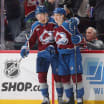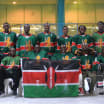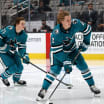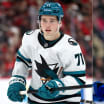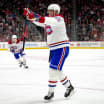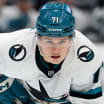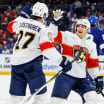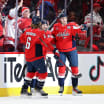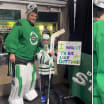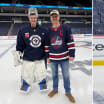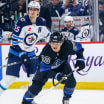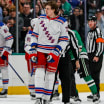Barkov brings unique two-way game to Panthers, game film shows
Viewing video with Florida coaches reveals what makes center so effective

© Getty Images
"Back it up," he says in a conference room at their practice rink. "Right here. Watch."
On the screen is center Aleksander Barkov, the 22-year-old whom general manager Dale Tallon calls the best 200-foot player in the game, a candidate to win the Selke Trophy as the NHL's best defensive forward and the Lady Byng Trophy for sportsmanship and excellence.
We wanted to look through the Panthers' eyes to see the little things that set Barkov apart, so Ben Cooper, the assistant in charge of video, pulled clips of their 3-1 home win against the Vancouver Canucks on Feb. 6.
Barkov played 28 shifts. Cooper found 31 examples -- a highlight-reel goal and an empty-net goal, yes, but so many other plays that demonstrated his size, strength, speed, effort, discipline, technique, intelligence, creativity and, of course, skill.
When you see the clips one after another, you appreciate how many things Barkov does, and how he does them over and over again. When you hear the comments, you understand why some things that might seem insignificant are not. When you break down plays in slow motion, frame by frame, you see things you never saw before, even on plays that dropped your jaw on first glance.
"Stop it," Boughner says.
Cooper freezes the clip. Defenseman Aaron Ekblad has the puck in the left-wing corner in the defensive zone. Barkov faces him above the left hash marks.
"He's got his stick down," Boughner says. "He's giving him a target right now."
Cooper presses play. Ekblad banks the puck off the end boards to the opposite corner for partner Keith Yandle. Barkov curls just above the crease, stick down. He's what they call "low, slow and available" -- not antsy for offense, not taking off too early.
"We call this cutting the paint, the blue paint," Boughner says. "The rule is that he's going to be in the blue area so we have that little pop play."
Yandle has two Vancouver players in front of him, but he pops the puck past one of them toward the middle instead of firing it up the boards, because he knows, he trusts, that Barkov will be there. Barkov takes possession. The Panthers go on the attack.
"He seems like he's been in the League for a long time," says Los Angeles Kings center Anze Kopitar, who won the Selke and Lady Byng in 2015-16 and to whom Barkov often is compared. "He seems like he's got it figured out."
Barkov is averaging 22:17 of ice time this season, more than any other NHL forward. He has scored five shorthanded goals, the most in the League.
He has won 54.4 percent of his face-offs, including 58.3 percent in the defensive zone, second to Buffalo Sabres forward Ryan O'Reilly's 62.9 percent among players who have taken at least 1,000 face-offs.
The Panthers have 52.76 percent of the shot attempts with Barkov on the ice at even strength, a high number, even though he has started 41.64 percent of his shifts in the offensive zone, a low number, and has been matched against top competition.
Penalty minutes? Fourteen.
He has 53 points (19 goals, 34 assists) in 54 games even though he doesn't cheat for offense. He has 177 shots, 21st in the NHL, but the coaches have been on him to shoot. This is a player who is 18 for 34 in the shootout in his five NHL seasons. His 52.9 conversion percentage is third in NHL history among players with at least 30 attempts.
"He's so unselfish, right?" Boughner says. "He'd rather set someone else up other than score, and that's a problem of his. He's got to be more greedy."
Good problem to have.
"I'd give [Barkov] any award," Panthers forward Micheal Haley says. "You name it. We'll give it to him."
* * * *
To put the clips in context, consider Barkov's genetics, passion, training and work ethic.
Barkov is a 6-foot-3, left-shot, two-way center like his father, Alexander, who was from Novosibirsk in the former Soviet Union and had a long hockey career. Barkov was born in Tampere, Finland, because that's where his father played his last 10 seasons.
Growing up, he would go to practice with his father, hang out on the couch in the locker room and try out the men's sticks. He would spend four or five hours a day on outdoor rinks with his father, his mother, Olga, or his older brother, Juri.
"Every time I get to put my skates on, it was the best part of the day," Barkov says. "When you're skating outdoors, you play with your friends. You just have fun. You can do whatever you want -- play in the net sometimes, play with the ball, play with the puck."
His father always had something for him to practice. Even now, his father, who coaches a junior team in China, watches each Panthers game and gives him pointers in Russian via phone calls or messages.
"If I was really bad on defense, he would tell me, 'That's embarrassing,' " Barkov says. "I play one game, he tells me what to do better. I had that in my mind, so I do that all the time what he said. Next game, something different. Then, of course, I'm learning those things. Then I have many things in my head. I can read the game. It's not easy, but he made my life easier with those tips."
The Panthers held the No. 2 pick in the 2013 NHL Draft. They needed a left-shot center, and scout Jari Kekalainen, who had watched both Barkovs, pushed for Aleksander. After the Colorado Avalanche took center Nathan MacKinnon at. No. 1, the Panthers selected Barkov instead of forward Jonathan Drouin, who went to the Tampa Bay Lightning at No. 3, and defenseman Seth Jones, who went to the Nashville Predators at No. 4.
"He's always been so organized playing both ways," Kekalainen says. "We had a long discussion at the draft, but [the pick] looks good right now."
Looked good right away, actually, and not just because Barkov scored in his NHL debut, a 4-2 win at the Dallas Stars on Oct. 3, 2013. At 18 years, 31 days, he was the youngest player to score an NHL goal in 70 years. Forward Don Raleigh scored for the New York Rangers in a 5-2 loss to the Toronto Maple Leafs on Nov. 21, 1943, at 17 years, 147 days.
"Even when he was a rookie, he was really responsible at both ends of the ice -- really strong," Pittsburgh Penguins center Sidney Crosby says. "For a younger guy, he's a strong player -- strong on the puck, strong on face-offs, just a really responsible game. I mean, offensively I feel like he's just going to keep getting better and better, because he's so conscious of playing defensively. He probably could take more chances."
During 2014-15, Barkov's second NHL season, the Panthers acquired one of his favorite players growing up: forward Jaromir Jagr. They became linemates, and Barkov learned so much from the legend the rest of that season and over the next two seasons, from how to protect the puck with his body to how to work like never before. Barkov watched Jagr in the gym and came to his famous late-night skates.

© Getty Images
Jagr signed with the Calgary Flames on Oct. 4 and was assigned to Kladno in the Czech Republic on Jan. 29, but his influence lingers. Barkov has synthetic ice at his lake house in Finland, so he can shoot a couple hundred pucks a day outside in the summer, and a few tiles of it at his house in Florida too, so he can handle pucks whenever he gets the itch.
Before games, you can catch him in the gym working on his face-off technique or balancing on an exercise ball with a flat top, on one leg, shooting 4- to 8-pound medicine balls against the wall.
"I can't even stand on the [exercise] ball, let alone shoot a medicine ball with it," Haley says. "It's pretty impressive. And this is before the game. That would tire me out."
Barkov participates in virtually every practice, even optional skates, and works on skills others can't conceive. One time, when defenseman Mike Matheson was taking a warmup lap, Barkov followed through like he was shooting but actually had snapped a behind-the-back pass to him in one motion.
"I was just sitting there, like, 'Did he mean to do that?' " Matheson says. "Yeah, he did."
Barkov studies video of all his shifts and of opposing centers' face-offs. Still, maybe a couple of times a week if the Panthers are at home, you can catch him skating on his own at the practice rink -- not quite as late as he did with Jagr, but later in the day.
"Maybe [Barkov] needs to take a little more time off," Tallon says with a laugh. "You just let him be. That's what makes him tick. It's not going to kill him. Better than the other way. We're begging some of the guys to work out or to play hard. … It's amazing how he just loves to play and he loves to work out and he loves the game. He loves to be who he is."
Like Jagr, or like he did in his father's locker room as a kid, Barkov carries a big stick. The rule of thumb is that you cut your stick to your nose when off skates or to your chin when on skates. Barkov doesn't cut his stick. It goes to his eyebrows when he's on skates. It's almost as long as Ekblad's, and Ekblad is a 6-4 defenseman. It's a 102 flex, which is stiff, compared to Ekblad's 85 flex, which is whippy.
"Very, very rare," equipment manager Teddy Richards says.
It gives him immense reach. It helps him with puck protection, face-offs, deflections and stick checks. It's nearly impossible to lift his stick, and he lifts opponents' as if they are made of balsa wood, sneaky, waiting for the right instant to strike. Because of his strength, he still has a quick release and hard shot, and because of his hand-eye coordination, he still handles the puck in tight.
"One of the impressive things about him is, you put a pass anywhere near him, he's getting it," Yandle says. "You can't give him a bad pass. He handles everything in full stride."
Boughner says, "He's got, I would say, the best stick in the NHL."
* * * *
Boughner leans forward in his chair as Cooper plays clip after clip:
• Barkov skates beneath the goal line in the defensive zone and collides with Canucks defenseman Alexander Edler. Though Edler is the same size, Barkov wins the battle, staying on his feet as Edler falls.
• The Panthers lose possession in the offensive zone. Barkov is below the left hash marks. But he immediately accelerates with three strong strides and comes back with his stick on the ice.
When the puck slips off a stick in the neutral zone, Barkov is there.
"See how he works on that backcheck?" Boughner says. "He skates as hard as he can, stick down, and the puck [is] going to come through the middle. They're going to try to [go] east-west at some point. Stick's down. By leading with his stick as he's skating, he's in the right area to get the puck back every time."
• The puck rims around the boards in the defensive zone. Barkov scrambles over, turns his back to an opponent to shield the puck and wins the battle.
• Yandle passes to Barkov in the right circle. Barkov looks for a pass. He sees nothing open and teammates going to the net. Instead of forcing a pass and risking a turnover, he shoots, but it's not really a shot. It's a pass off the pads that creates a scoring chance for forward Evgenii Dadonov.
"Shooting from here, a lot of guys would not hit the pad," Cooper says. "They would hit the goalie's stick. That's an easy play for the goalie. He just puts it into the glass. [Barkov] actually gets it right on the pad, where the goalie has no choice but to kick it out in front for a rebound. That's a skill play. That's a subtle thing."
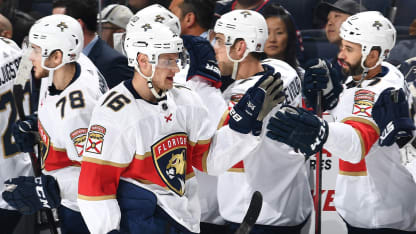
© Getty Images
• The Canucks enter the Florida zone. Forward Brock Boeser pulls up on the left wing and passes back to the point for defenseman Troy Stecher. Barkov reads it, stops and uses that long stick to deflect a shot by Stecher out of play.
• Barkov backchecks and swipes the puck from forward Jake Virtanen below the goal line.
• The Canucks try a give-and-go along the right-wing boards in the offensive zone, but Barkov sniffs it out, stick on the ice, and intercepts the pass.
"Just makes it look easy, and now on a dime, he turns, goes the other direction," Cooper says. "Now he's on offense. Goes from defense to offense in a heartbeat."
• The Panthers gain possession in the defensive zone. Barkov slashes from left to right across the neutral zone with only defenseman Ben Hutton in front of him.
Defenseman Mark Pysyk passes the puck up to Barkov, who takes it, scoots past Hutton and scores to give the Panthers a 2-1 lead 16:08 into the second period.
Wait.
"You've got to watch this is slow motion," Cooper says.
Cooper rewinds the clip, then goes frame by frame. The pass comes from behind Barkov. Hutton is directly in his path, skates angled toward him. If Barkov catches the pass on his blade, Hutton can step up to hit him or force him toward the boards. So instead, in a split second, Barkov one-touches the puck with the heel of his stick to the left and into open space. Hutton flails as Barkov cuts to the puck.
"If I'm a D that's trying to read a pass and I'm going to step up and try to smoke someone, I'm counting on the fact that their momentum is going to keep going to where it's going," Matheson says. "And if you watch [Barkov] in practice, every single one of those passes where he's kind of looking back, he'll either catch and take a step this way, or catch it and do what he did in that game. He never stays consistent. He protects himself that way."
Wait. There's more.
Hutton whacks Barkov on the hands from behind on the left so hard that a referee raises an arm to call a penalty. Defenseman Erik Gudbranson charges from behind on the right. Barkov lifts his stick and holds out his right leg to protect the puck, then chips a backhand past goaltender Jacob Markstrom.
"You really see the little things of the body movement and how he knows a guy is positioned a certain way and how he can expose that," Cooper says. "He doesn't even have to look. He can just sort of see it and sense it.
"And by the way, watch the celebration. How humble is that?"
Barkov glides around the corner, holsters his stick and greets his teammates.
• With Florida protecting a one-goal lead in the third period, Barkov reaches out to deflect a shot by defenseman Michael Del Zotto out of play.
• He gets low for a defensive-zone face-off, and then, as soon as the puck drops, he moves his body over the dot to claim the space and win the draw.
• Instead of going on the offensive side of a loose puck, he goes on the defensive side to be safe. He gets his stick on it with one hand, jabs it to a teammate, goes to the net and gets a scoring chance anyway.
• He makes sure he's between Boeser and the net in the slot, never losing his man.
• Instead of trying to puck-handle through players at the offensive blue line, he chips the puck past them, skates past them and retrieves it at the end boards.
• Barkov carries the puck into the offensive zone on the left wing with Boeser on his back and centers the puck.
"Watch that again," Cooper says, rewinding, then going frame by frame. "Just appreciate."
Boeser tries to use his stick on Barkov -- left, right, left. No chance.
• Barkov takes the puck along the right-wing boards, fights off two Vancouver players and keeps the puck in the zone.
• Finally, the empty-netter. Trocheck gains possession in the defensive zone and banks the puck ahead off the left-wing boards. Barkov will have played 24:36 on this night, yet he has the burst to outrace Edler, who tries to hook and slash him, and scores to make it 3-1 with 42 seconds remaining in the third.
"It's empty net," Barkov says, smiling. "Everybody has legs."
* * * *
One more clip.
This one is from Nov. 22, when the Panthers hosted the Maple Leafs and Barkov wore a microphone for Fox Sports Florida.
LISTEN IN: @FlaPanthers center Aleksander Barkov was mic'd up against the Maple Leafs! Hear all his reactions in the game! #OneTerritory pic.twitter.com/ved85FHD2S
— Bally Sports Florida & Bally Sports Sun (@BallySportsFL) November 23, 2017
Barkov scores in the shootout, pulling the puck to his backhand, flicking it past goaltender Frederik Andersen one-handed. As the Panthers celebrate a 2-1 victory, forward Vincent Trocheck hugs Barkov.
"Aw, dude," Trocheck says. "That was nasty."
Matheson gives Barkov a pat on the back.
"Thank you for being my teammate," Matheson says.
Yandle looks at him in awe.
"Is this game even fun for you?" Yandle asks.
Barkov just smiles.
"We all joke that he's our favorite player, but he is," Matheson says. "He's a great player, and we're lucky to have him."

